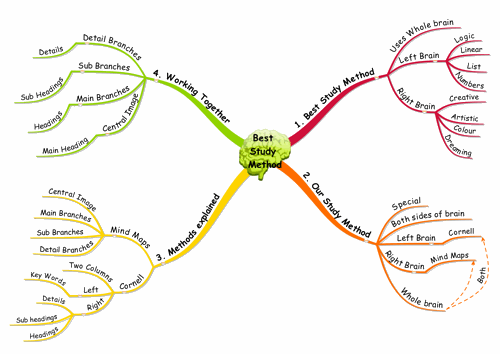The best study method in the world

What is the best study method in the world?
Get Access to the Best Mind Mapping Tips, Tools, Techniques Resources and Opinions. You might be thinking that this guy is very bold to even attempt an answer to this question! The answer is quite simple though - The best study method is any method that utilises the whole brain! A mind map study method is perfect when it comes to utilising your whole brain, as mind maps allow you to fully utilise your left and right brain. Scientists have now almost universally agreed that the left and right halves of the brain largely have different functions. (For those of you that don't know, the brain looks very much like a walnut, with two visibly distinct halves.)
The left side of the brain is the logical side and deals with lists, numbers and structured information, etc., while the right side of the brain is the creative side and handles colour, sensory experiences and unstructured information.
While the above is not entirely true, as both halves share some functions, using both the creative side and the structured side in learning will greatly improve retention and understanding and soon you could also be employing the best study method in the world.
You now have a very good yardstick to measure any study method by.
This is even easier than the first question - our study method is so special because it actively incorporates both sides of the brain!
It uses Mind Maps, and the Cornell Method. The artistic, visual, creative learners will be more comfortable with Mind Maps, while the logical, linear learners will be more comfortable with the Cornell Method.
By using both these methods, will the whole brain be used.
The Mind Map Study Method uses Mind Mapping. It allows you to record whole chapters, sections and even complete books on a single page. Many pages on this website have an overview Mind Map on the top of the page. We believe that Mind Maps are an essential tool if you want to develop the best study method.
If you are not sure what a Mind Map is, have a look at our article, 'What is a Mind Map?'
Simply put, a Mind Map consists of the following:
Subscribe to Using Mind Maps
Why is our study method so special?
What are these methods?
Mind Mapping
If you are new to Mind Mapping, just browse this site and look at the mind map examples to get a general feel of the concept. A Mind Map can be overwhelming initially. If this is the case, simply focus on one branch at a time and soon your mind will build the necessary hooks for the information to attach to and soon you will be immersed in the best study method for yourself - one that uses the whole brain.
I will show you how to convert a Mind Map to a linear note, making it easier for those used to regular, linear notes.
The Cornell Method
The Cornell method is actually quite brilliant in its simplicity. To use the method, simply take an A4 sheet of paper and draw a 6cm column on the left hand side.
Key Words will be placed on the left hand side and details on the right hand side.
That's it! No complications, no fuss. Just easy to use, brilliant methods.
An overview of these methods can be found on the Mind Map Notes page.
Working together
If converting from a Mind Map to the Cornell Method:
- The central Topic becomes the main heading
- Each Main Topic becomes a heading
- Each SubTopic becomes a Key Word on the left hand column
- Each detail branch gets recorded on the right hand side, with Key Words possibly highlighted.
- The main heading becomes the central topic
- The headings become main topics
- The keywords on the left hand side become SubTopics
- The paragraphs on the right hand side get converted to detail branches.



